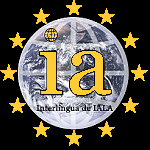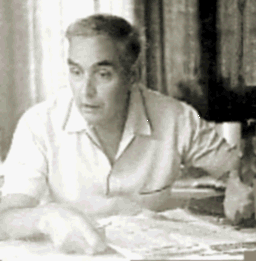Related Research Articles

Interlingua is an Italic international auxiliary language (IAL), developed between 1937 and 1951 by the International Auxiliary Language Association (IALA). It ranks among the top most widely used IALs, and is the most widely used naturalistic IAL: in other words, its vocabulary, grammar and other characteristics are derived from natural languages, rather than being centrally planned. Interlingua was developed to combine a simple, mostly regular grammar with a vocabulary common to the widest possible range of western European languages, making it unusually easy to learn, at least for those whose native languages were sources of Interlingua's vocabulary and grammar. Conversely, it is used as a rapid introduction to many natural languages.

Richard "Ric" Berger (1894–1984) was a Swiss professor of design, decoration, and art history. He is best known for his numerous newspaper articles about historical monuments, mainly in the French-speaking part of Switzerland, including his own drawings of the buildings. Through these articles, he contributed to an increased interest in historical monuments and settings among many hitherto uninformed people, and probably also contributed indirectly to a wider interest in preserving and saving historical monuments from destruction.
Alexander Gottfried Friedrich Gode-von Aesch, or simply Alexander Gode, was a German-American linguist, translator and the driving force behind the creation of the auxiliary language Interlingua.
The Union Mundial pro Interlingua is a global organization that promotes Interlingua, an international auxiliary language (IAL) published in 1951 by the International Auxiliary Language Association (IALA). UMI was founded on July 28, 1955, when the first International Interlingua Congress took place in Tours, France. The UMI collaborates with the national Interlingua organizations and has a hand in publishing dictionaries, grammars and tutorials. It is a non-profit organization that now operates out of Bilthoven, Netherlands.
Piet Cleij was a Dutch linguist. He was the former vice-secretary of the Union Mundial pro Interlingua and the chief lexicographer in the Interlingua community.
Panorama in Interlingua is the primary periodical for the language Interlingua, published bimonthly. It was first issued in January 1988. The magazine is based in Odense, Denmark, and is written completely in Interlingua and the activities of the Union Mundial pro Interlingua (UMI) appear in each issue, but the content is not necessarily about the language itself. Thomas Breinstrup, the editor in chief, is considered a leader of Interlingua style.
Interlingua: A Grammar of the International Language, sometimes called the Interlingua Grammar, is the first grammar of Interlingua. Released in 1951 by the International Auxiliary Language Association (IALA), it remains an authoritative reference work for Interlingua speakers and students of linguistics.
Alix Potet, who obtained her doctorate of sciences in 1990, is professor of informatics at the University of Rennes. Potet is Vice President of the Union Interlinguiste de France (UIF) as well as co-author of the French-language supplement to the manual Interlingua by Ingvar Stenström (1988) and of a French-Interlingua dictionary (1991).
Interlingua, Instrumento Moderne de Communication International by Ingvar Stenström is a popular Interlingua course. As of 2006, it has been translated into Bulgarian, Danish, French, German, Hungarian, Portuguese, Romanian, Russian, and Swedish; translations into Norwegian and Lithuanian are in final preparation, and five additional languages are expected to follow.
Interlingua dictionaries are notable for their comprehensiveness; they tend to be larger than for other auxiliary languages. Some of the larger dictionaries are presented here.
Július Tomin (1915–2003) was a high school teacher and well-known author from Czechoslovakia. He was persecuted during the Soviet occupation for promoting Interlingua as a second language.
Jurij Cherednikov is a Ukrainian-American author and software engineer. He was the first representative of the Union Mundial pro Interlingua in Ukraine and co-founder of the Ukrainian Interlingua Society.
The Ukrainian Interlingua Society, works in Ukraine to promote the knowledge and active use of Interlingua. It supports the work of the Russian representative of the Union Mundial pro Interlingua.
Engelbert Pigal was an Austrian engineer. A speaker of Interlingua and two other auxiliary languages, he wrote two cosmological monographs in Interlingua.
Wilhelm Bladin was a noted progressive teacher and author born in Gävle, Sweden. He compiled grammars, manuals, and dictionaries in English, German, French, and Interlingua. He was the second Secretary General of the Union Mundial pro Interlingua for Sweden.
The Union Interlinguiste de France, established in 1961, works to increase public knowledge and active use of Interlingua. It produces the magazine Unir, written in French and Interlingua and also established in 1961. In addition, the UIF makes other Interlingua publications available, arranges conferences and a General Assembly, submits articles to the mainstream press, and issues press releases. In 2007, the UIF was instrumental in gaining recognition of the Union Mundial pro Interlingua as an international organization.
Lingua e Vita is the official magazine of the British Interlingua Society (BIS). Founded in 1965 as an initiative of Brian C. Sexton, Lingua e Vita is a continuation of the earlier organ of the BIS, the Circular Letter.
The history of Interlingua comprises the formation of the language itself as well as its community of speakers.
André Schild : born in Fontainemelon or Cernier in the Swiss canton of Neuchâtel. He was a linguist and former administrator of the Universal Esperanto Association in Geneva. He taught at the Benedict School (Bénédict-Schule) in Basel. He published the outline of his Neolatino system in 1947.

A pan-Romance language or Romance interlanguage is a codified linguistic variety which synthesizes the variation of the Romance languages and is representative of these as a whole. It can be seen as a standard language proposal for the whole language family but is generally considered a zonal constructed language because it's the result of intense codification. Zonal constructed languages are, according to interlinguist Detlev Blanke, constructed languages which "arise by choosing or mixing linguistic elements in a language group".
References
- Wilgenhof, Karel, Grammatica de Interlingua (revised and expanded edition). Union Mundial pro Interlingua, 1995.